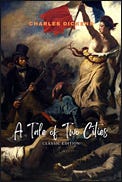The opening passage of A Tale of Two Cities is well known: “It was the best of times, it was the worst of times…” After a series of extravagant contrasts, Dickens reaches his main point: “in short, the period was so far like the present period, that some of its noisiest authorities insisted on its being received, for good or evil, in the superlative degree of comparison only.” In short, he means Paris before the Revolution was alarmingly similar to his own Victorian England, an extravaganza of conspicuous consumption for the upper classes, a swamp of despair for the lower—and potentially a breeding ground for the kind of violence that ruled Paris after the French Revolution.
Dickens paints his characters in vivid strokes: the sinister Madame Defarge knits coded sentences of revenge into her woolies; pretty Lucie Manette dotes with anxious saintliness on her wrongly imprisoned father; shabby Mr. Cruncher, scrambling to escape destitution as best he can, thrashes his praying wife and lives in fear lest her prayers foil his illegal schemes. For twenty-first century readers, Dickens’ prose may take some getting used to, but his plot is as full of near escapes and sudden reversals of fortune as any modern thriller. Bestsellers in their own time, his novels awakened the public conscience, prompting reforms of many of the abusive institutions he described. (1859; most editions of A Tale of Two Cities run 350-450 pages)




